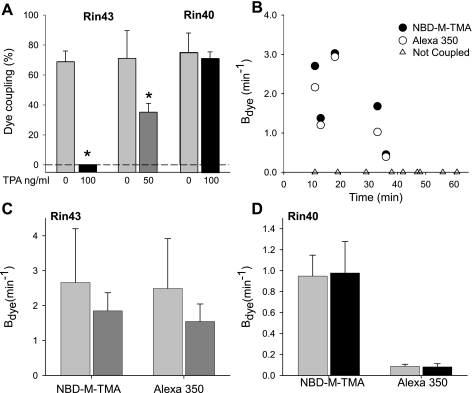Fig. 5.
Incidence and extent of dye coupling are reduced following PKC activation in Rin43 but not Rin40 cells. A: the percentage of dye-coupled cell pairs for untreated (light shaded bars) vs. TPA-treated (dark shaded bar 50 ng/ml; solid bars 100 ng/ml) Rin43 and Rin40 cells. Coupling in treated pairs is compared with untreated pairs from cells plated simultaneously on the same day; the percentage of coupled pairs on a coverslip was determined, and the mean across multiple coverslips was determined. TPA reduced dye coupling in the Rin43 cells (untreated: 6 coverslips, 37 cell pairs; treated: 3 coverslips, 18 cell pairs) but had no effect at the highest concentration on Rin40 junctions (untreated: 5 coverslips, 31 cell pairs; treated: 5 coverslips, 18 cell pairs). B: NBD-M-TMA and Alexa 350 permeances decreased in parallel as a function of TPA (50 ng/ml) treatment duration in treated Rin43 cells. C: there was a downward trend in average permeance (Bdye) for NBD-M-TMA and Alexa 350 for Rin43 cells that were TPA treated (50 ng/ml, dark shaded bars; untreated controls, light shaded bars). D: no differences were detected in the average permeances for NBD-M-TMA and Alexa 350 (Bdye) in Rin40 cells untreated (light shaded bars) or treated with TPA (100 ng/ml; solid bars). *Dye coupling in TPA-treated cells significantly different from untreated cells (Student's t-test).

